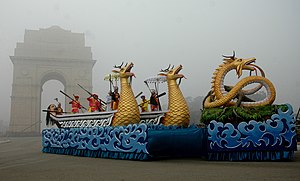
Back পান্থোইবী Assamese Panthoibi English पान्थोइबी Hindi Panthoibi HIF ꯄꯥꯟꯊꯣꯏꯄꯤ MNI பந்தோய்பி Tamil Пантхойбі Ukrainian پینتھوبی Urdu
| Panthoibi (Old Manipuri: Panthoipi) | |
|---|---|
Goddess of civilization, courage, fertility, handicraft, love, victory, warfare and wisdom | |
| Member of Lairembis and Umang Lais | |
 Goddess Panthoipi charging forward riding on her white horse | |
| Other names |
|
| Affiliation | Meitei mythology (Manipuri mythology) and Meitei religion (Sanamahism) |
| Major cult center | Nongmaiching Hill (alias Selloi Langmai Hill) |
| Abode | Nongmaiching Hill (alias Selloi Langmai Hill) |
| Weapons | Spear and Sword |
| Artifacts | Kajenglei |
| Animals | white horse or tiger |
| Symbol | Kajenglei |
| Mount | white horse or tiger |
| Texts | |
| Gender | female |
| Region | Ancient Kangleipak (Antique Manipur)[1] |
| Ethnic group | Meitei ethnicity |
| Festivals | |
| Consorts | Tarang Khoinucha and Nongpok Ningthou |
| Equivalents | |
| Greek equivalent | Athena, Aphrodite |
| Roman equivalent | Minerva, Venus |
| Etruscan equivalent | Menrva, Turan |
| Hinduism equivalent | Durga[2] |
| Egyptian equivalent | Neith, Hathor and Isis |
Panthoibi (Meitei: ꯄꯥꯟꯊꯣꯢꯕꯤ) or Panthoipi (Old Manipuri: ꯄꯥꯟꯊꯣꯢꯄꯤ) is a goddess in the Meitei mythology and religion. People in Ancient Kangleipak (Antique Manipur) worshipped her.[3] She is the goddess of civilization, courage, having children, making things with hands, love, winning, war and wisdom.[4][5][6][7] She is married to Nongpok Ningthou.[3]
Col. John Shakespear wrote that Panthoibi is the most famous goddess in the Meitei religion.[8][9]
People talk about Panthoibi with another goddess, Leimarel Sidabi. Sometimes people think of Panthoibi and Leimarel as the same goddess.[10]
People say Panthoibi is bold, brave, and independent. She always works for what is good and right for Meitei women.[11]
- ↑ Singh, T. S. P. (2018-05-31). Apology. Partridge Publishing. p. 7. ISBN 978-1-5437-0188-3.
- ↑ "Panthoibi celebrations under way". www.telegraphindia.com. Retrieved 2022-06-13.
- ↑ 3.0 3.1 Jain, Jyotindra (1998). Other Masters: Five Contemporary Folk and Tribal Artists of India. Crafts Museum and the Handicrafts and Handlooms Exports Corporation of India.
- ↑ Parratt, Saroj Nalini (1997). The Pleasing of the Gods: Meitei Lai Haraoba. Vikas Publishing House. ISBN 978-81-259-0416-8.
- ↑ Session, North East India History Association (2001). Proceedings of North East India History Association. The Association.
- ↑ Singh, R. K. Jhalajit (1992). A Short History of Manipur. R.K. Jhalajit Singh.
- ↑ Social Movements in Contemporary India - Page 98 - Bidyut Chakrabarty, Shibani Kinkar Chaube · 1999
- ↑ The Purums: An Old Kuki Tribe of Manipur - Page 207 - Tarakchandra Das · 1945
- ↑ Anthropological Papers - Page 208 - Calcutta University Press, 1945
- ↑ Devi, Dr Yumlembam Gopi. Glimpses of Manipuri Culture. Lulu.com. p. 23. ISBN 978-0-359-72919-7.
- ↑ Kipgen, Tingneichong G. (2010). Women's Role in the 20th Century Manipur: A Historical Study. Gyan Publishing House. ISBN 978-81-7835-803-1.
